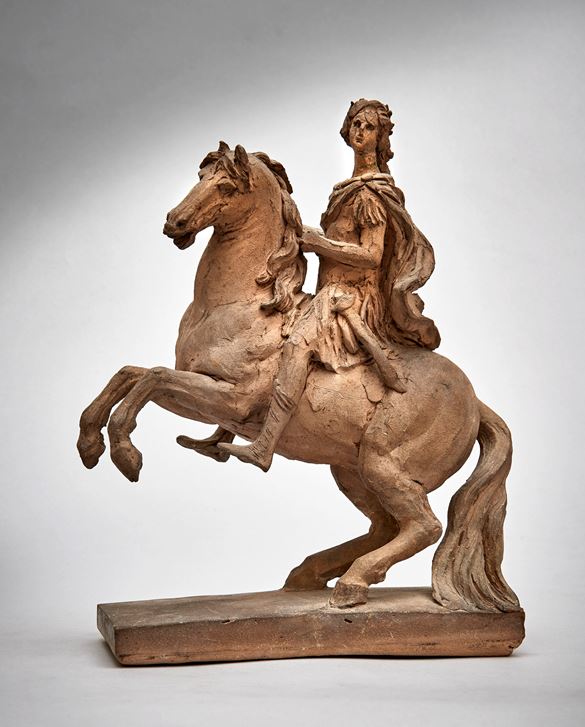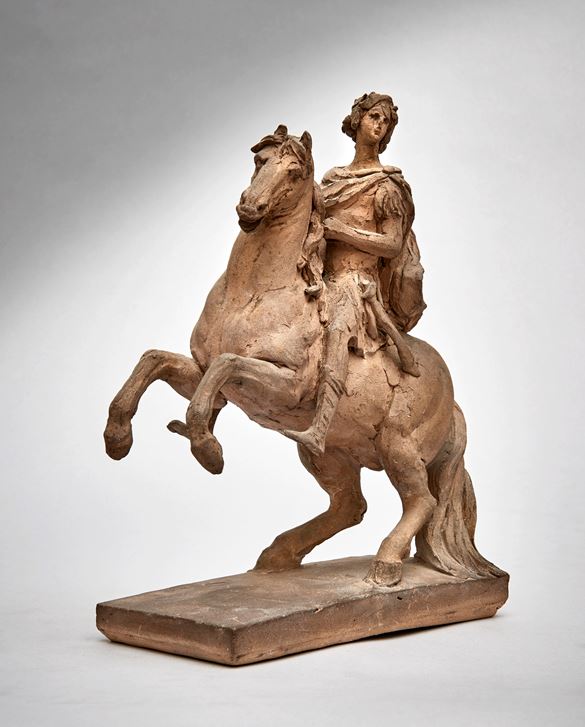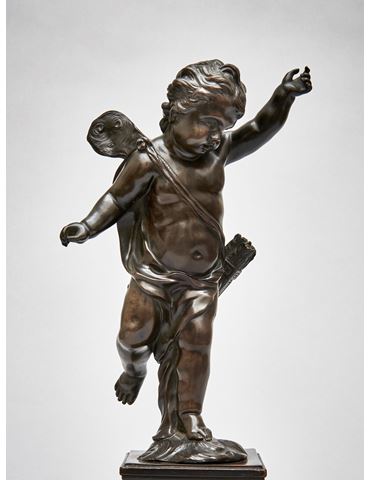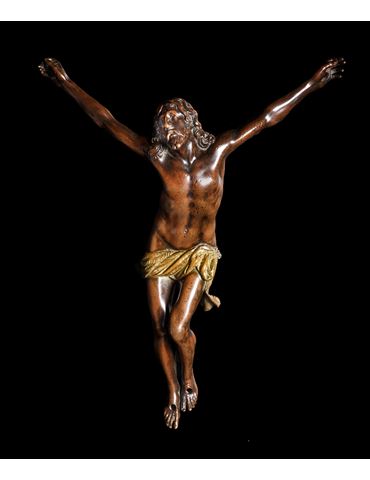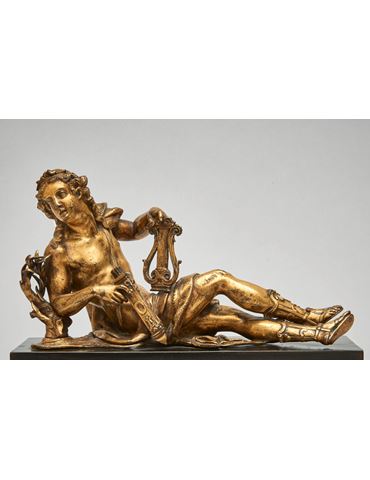Jacques-Philippe Bouchardon
Chaumont-en-Basigny 1711 - Stockholm 1753
Adolf Fredrik, King of Sweden
Mounted on a rearing stallion, probably made to celebrate his accession in 1751
Terracotta maquette
On original blackened oak pedestal
Height of terracotta alone: 25 cm (9¾ in)
Dimensions of pedestal: 16.5 x 25 x 15.5 cm (6½ x 9¾ x 6 ⅛ in)
Terracotta maquette
On original blackened oak pedestal
Height of terracotta alone: 25 cm (9¾ in)
Dimensions of pedestal: 16.5 x 25 x 15.5 cm (6½ x 9¾ x 6 ⅛ in)
ENQUIRIES
+44 (0)20 7259 0707
Provenance:
Louis-Bonaventure Girard, nephew of Edme and Jacques-Philippe Bouchardon; included in his posthumous sale, Paris, 13 Sept. 1808, p. 32, lot 247: ‘La statue équestre de Louis XV, piédestal de bois noirci, sous cage de verre’ 1 - bought by Laillaut; Laillaut de Wacquant, collateral line of Bouchardon's descendants;2 Gustave Laillaut, cited in 1897 and 1908; Mme. Laillaut, Saint-Dizier, cited in 1910; Laillaut estate, sold by Pomez & Boisseau, Hôtel des Ventes, Troyes, 17 May 1987.
The terracotta’s earlier history is not known, but it may have been part of lot 18 in Edme Bouchardon’s posthumous sale held in Paris, 1-8 December 1762, p. 12 - 'Nombre de figures en terre cuite ou en plâtre, bien conservées, exécutées pour la plûpart par M. Bouchardon’. Louis-Bonaventure Girard had attended Edme Bouchardon’s funeral on 28 July 17623 and his mother Marie-Therèse Bouchardon, one of the sculptor’s five siblings, was ‘Héritière présomptive pour un cinquième dud. deffunt s. Bouchardon’.4 Although the introduction to the catalogue of 1808 states that Louis-Bonaventure himself had been the legatee,5 at least one lot, the wax presentation model (no. 249), had belonged to Louis-François Trouard and his pupil Pâris.6 The present terracotta may also have entered Girard’s possession by a similarly indirect route, such as the collection of Count Carl Gustaf Tessin.7
Literature: A. Roserot, 'La statue équestre de Louis XV par Edme Bouchardon' in Gazette des Beaux-Arts ... 3ème période, vol. XVII, no. 477, March 1897, pp. 198-201 (illu). J. Guiffrey & P. Marcel, Inventaire Général des Dessins du Musée du Louvre et du musée de Versailles, vol. II, Paris, 1908, p. 15. A. Roserot, Edme Bouchardon, Paris 1910, pp. 102 & 158, p. 101 (illu). La statue équestre de Louis XV, exh. cat., Paris, Musée du Louvre, Cabinet des Dessins, 13 January - 30 April 1973, p. 33, no. 71.
Exhibition: Edme Bouchardon. Sculpteur du Roi 1698-1762, Chaumont, 1962, p. 28, no. 120. Sculptures de maîtres anciens, Galerie d'Arenberg, Brussels, 1991, pp. 26-30, no. 7.
The present terracotta maquette has a long and distinguished history. It was published by Alphonse Roserot in 1897 as a preliminary model by Edme Bouchardon for the monument of Louis XV on a walking horse destined for Place Louis XV (de la Concorde), which was commissioned on 17 July 1748. More recently, Roserot’s attribution has been questioned by Guilhem Scherf.8 Of the several hundred drawings made by Bouchardon, none represents the rearing horse portrayed in the present terracotta; the extant drawings are all studies for the final design chosen by the king as represented in the wax, wood and plaster presentation model, now in the Museé des Beaux-Arts, Besançon. Primarily, the modelling of the horse and rider seen in the present terracotta is sufficiently different from Edme’s executed designs to suggest that Roserot was mistaken in his identification. However the modelling of the horse’s head and the design of its blackened oak base are very similar indeed to a documented work by Edme’s younger brother, Jacques-Philippe Bouchardon, who was sculptor to the Swedish court from 1741 until his death in 1753. Writing to one of Bouchardon’s relatives on 30 July 1754, de Rossignol refers to a model for a marble group of Prince Karl, Grand Admiral of Sweden, which Jacques-Philippe had made for the Queen of Sweden circa 1751.9 This terracotta model (h. 48 cm), now in the National Museum, Stockholm, represents a small boy riding on the back of a sea-horse. The head, neck and mane of the sea-horse are identical in type and style to the rearing horse in the present terracotta, and both maquettes are mounted on identically styled and proportioned black wood bases. In both instances the sculptor used wax to model some of the more delicate parts; the drapery billowing over the young prince’s right shoulder and, in the present terracotta, traces of red wax are visible on the rider’s raised right hand and on his thigh where he once held a baton. The depiction of the horses in both terracottas recalls a type created for Louis XIV by Martin Desjardins.10
In the 1680s, Desjardins received commissions for two bronze monuments of Louis XIV on horseback, one for Lyons and another for Aix-en-Provence. The Lyons monument (destroyed 1792) depicted the king astride a walking horse, as shown in engravings and a bronze reduction by Nicolas Delacolonge dated 1726. When the Swedish architect Nicodemus Tessin visited Desjardins in 1687, Desjardins described to Tessin the life-size monument of Louis XIV on a rearing horse that he had conceived (but never cast) for Aix-en-Provence, in which the weight of the sculpture was supported by the tail of the horse.11
While in Paris in 1700, Daniel Cronström (also of Swedish origin) tried to negotiate the purchase of a four-foot high plaster model of Louis XIV on a walking horse (Lyons type), a smaller model of the king on a rearing horse (Aix-en-Provence type) and a large model of the same12 probably the full-size plaster formerly at Versailles. Only able to acquire the first two of these three models, Cronström had them sent to Stockholm, where they had arrived by 25 June 1704. The large plaster of Louis XIV on a walking horse arrived broken into pieces. The other group is likely to have represented King Karl XII of Sweden on a rearing horse victorious over his foes.13
Two examples of this composition - in bronze and gilded plaster, both 48.5cm (19in) high (excluding Victory), are now in the National Museum, Stockholm.14 One, as outlined below, is likely to have been in Stockholm since 1704. The other was seen in Paris circa 1742 by Karl Reinhold Berch, who suggested that it would look good on a marble table at Drottningholm, the royal palace outside Stockholm.15 Although Berch described the group he had seen in Paris as bronze, it remains uncertain which of the two he had seen, as gilded plaster, at a distance or in poor light, could easily have been mistaken for gilt bronze.
Contemporary references to one of Desjardins’s models being used to portray King Karl XII and to the size of these models endorse the view that the group which survived shipment in 1704 was of Karl XII on a rearing horse. In a letter dated 8 October 1700, Cronström proposed replacing the head of Louis XIV on one of Desjardins’s models with a portrait of King Karl XII of Sweden. And in the same letter he described how the sculptor’s nephew, Jacques Desjardins, from whom he had bought the plaster of Louis XIV on a walking horse, could also supply small-scale bronzes from his uncle’s models of the Lyons and Aix type;16 ‘Son neveu qui me l’a vendu pourra me le donner en bronze sur 15 à 18 pouces de haut, et mesme le cabré, tous deux très corrects et modelés par feu son oncle’, (i.e. 40.5-48.5 cm or 16-19 in); casts signed by Roger Scabol and by Guillem de Groff are known.17 A cast of the latter model depicting Louis XIV on a rearing horse (h. 48 cm.), survives in a French collection.18 The Stockholm groups of King Karl XII resemble it so closely in every detail, including the vanquished foes cowering beneath the horse, that there can be no doubt they represent the compositions envisaged by Cronström in 1700. The irrefutable evidence, that equestrian groups cast from Martin Desjardins’s models were in the Swedish royal collection during the twelve years that Jacques- Philippe Bouchardon lived there, explains why a terracotta by a Louis XV sculptor working in Stockholm might resemble works by a Louis XIV sculptor working in Paris. This similarity led Lorenzo Hammarsköld in 1817 to attribute to Jacques-Philippe Bouchardon the Desjardins equestrian bronze of Karl XII.19
The present terracotta more probably represents King Adolf Fredrik (1710-1771) than Karl XII (whose posthumous bust Jacques-Philippe had modelled in 1747).20 Bouchardon had arrived in Stockholm in the summer of 1741 during the reign of Frederick I, but several of his later commissions were from Adolf Fredrik, the German heir to the Swedish throne (acceded 1751), and his wife Louisa Ulrica, sister of Frederick the Great. Among the works known to have been made for them by Bouchardon are a bronze bust of Adolf Fredrik, signed and dated 1749, and portraits of their sons Gustav (1746-92) and the infant princes Karl (described above) and Fredrik Adolf.21
Inspired by the triumphant image of the hero-king Karl XII then in the royal collection,22 the present terracotta may well reflect one of Bouchardon’s ideas for celebrating Adolf Fredrik’s accession to the Swedish throne in 1751; especially as de Rossignol’s letter of 1754, quoted above, shows that Jacques-Philippe prepared models for the royal couple and presented them for approval.
Biographical Note:
Bouchardon enlisted in the army in 1730, but bought himself out with the help of the Comte de Caylus. By 1735 he was in Paris, working in the atelier of his elder brother Edme, who had also studied with their father, Jean-Baptiste. In July 1741 Count Carl Gustaf Tessin, the Swedish ambassador and a great collector, engaged Jacques-Philippe to work on the royal palace in Stockholm. His contract was renewed in January 1746 and the sculptor spent the rest of his life in Stockholm working on sculptural ornamentation for the palace and producing portrait busts.22
1. 'TERRE CUITE Par BOUCHARDON' appears above lot 246 and lots 247-251 were all prefixed 'Par le Même': '246 Une tête d’Ecclésiastique ... 248 La Statue de la fontaine de Grenelle, sur piedestal de bois. 249 La statue équestre de Louis XV, mutilée, en cire, sous cage de verre. 250 Un Mausolée sculpté en bois, dans une niche vitrée. 251 Autre Mausolée en cuivre, enfermé comme le précédent.'
2. Guiffrey & Marcel, Inventaire général des dessins... II, 1908, p. 15. Roserot drew on information contained in Bouchardon’s papers held by the Laillaut family.
3. Roserot 1910, p. 147 and S. Lami, Dictionnaire des Sculpteurs de l’école française au dix-huitième siècle, vol. I, Paris, 1910, pp. 102-103.
4. J. Guiffrey, ‘Scellés et inventaires d’artistes ... 1741-1770 ‘ in Nouvelles archives de l’art français, 2nd series, vol. V, 1884, p. 316; the inventory of his household contents drawn up by François Girard, his brother-in-law, is reprinted as no. cxcv on pp. 310-318. Edme Bouchardon’s will is held in Paris at the Archives Nationales, Minutier central des notaires, Etude Mouette, lxxvi, liasse 384 (kindly advised by Prof. Souchal).
5. ‘Au moment de terminer sa carrière, M. Bouchardon testa en faveur de M. Girard son neveu, et il le fit légataire de cette précieuse collection’.
6. Sold Paris, 22-29 Feb. 1779, p. 60, lot 299 - ‘un petit modèle en cire de la statue équestre de Louis XV’. For Trouard, see J. Turner (ed.), The Dictionary of Art, London, 1996, vol. 31, pp. 372-373. Sold to Pâris, probably Pierre-Adrien Pâris (1745-1819): see idem., vol. 24, pp. 176-7.
7. Tessin had negotiated Jacques-Philippe Bouchardon’s contract dated 31 July 1741 (A. Lindblom, Jacques-Philippe Bouchardon, Uppsala 1924, p. 179). Swedish ambassador in Paris 1739-42 and prime minister to Adolf Fredrik 1747-52 (The Dictionary of Art, 1996, vol. 30, pp. 523-24). Sales of his collection - Akerö Castle , 4-16 Feb. 1771 and Stockholm , 26 ff. July 1771 (Lugt 1887& 1949).
8. G. Scherf in Bronzes de la Renaissance à Rodin. Chefs d’oeuvre du musée du Louvre, exhib. cat., Tokyo-to Bijutsukan/Tokyo Metropolitan Art Museum, 10 Sept -6 Nov 1988, p. 239, see cat. no. 32.
9. Lindblom 1924, p. 146-7 & fig. 75. The prince (born 7 Oct 1748 ) must have been under five when the model was made, as Bouchardon died in December 1753. The sculptor visited Rome in 1751. Cf. Edme Bouchardon’s lead groups of putti on sea-monsters for the Bassin de Neptune at Versailles.
10. F. Souchal, French sculptors of the 17th and 18th centuries. The reign of Louis XIV. A-F, Oxford 1977, pp. 257-9, cat. nos. 46-7 and idem, Supplementary volume A-Z, 1993, pp. 74-6.
11. O. Sirén, Nicodemus Tessin d. y:s Studieresor i Danmark, Tyskland, Holland , Frankricke och Italien, Stockholm 1914, p. 106. In 1685 Gobert had made a bronzed plaster of the king on a galloping horse.
12. L. Seelig, Studien zu Martin van den Bogaert gen. Desjardin (1637-1694). Inaugural-Dissertation ... Ludwig-Maximilians-Universität zu München, Hamburg 1980, pp. 519-20, cat. LIII/6; quoting from letters published by R.-A. Weigert & C. Hernmarck in Nationalmusei Skriftserie 10. Les relations artistique entre la France et la Suède 1693-1718. Nicodème Tessin le jeune et Daniel Cronström. Correspondance (extraits), Stockholm 1964.
13. Seelig 1980, pp. 543-4 & 585-8, cat. nos. LIV/38 & LXXVI. Seelig omitted to make this connection.
14. Seelig 1980, p. 566, cat. no. LX & Souchal, A-F, p. 261, no. 55.
15. A. Lindblom, Fransk barock- och rokokosculptur i Sverige, Uppsala 1923, pp. 32-3.
16. See n. 13 above.
17. Jacques Desjardins, sculptor and founder, may have cast some of his uncle’s models himself, but others are signed by Guillem de Groff and by Roger Scabol (contracted 19 March 1693 to make mould for Lyons monument by Martin Desjardins; his small-scale bronze with casting rods attached is now in Copenhagen ). In 1701 seven bronzes by Scabol were purchased by Max Emanuel of Bavaria (lived in Brussels 1692-1701 & 1706; in Paris 1709-14) and Scabol’s fine bronze of the Kurfürst on a rearing horse, signed and dated 1707, is in a New York private collection. De Groff’s cast dated 1714 of the same sitter is in the Bayerisches Nationalmuseum, Munich (de Groff was also in Paris 1708-14). Kurfürst Max Emanuel Bayern und Europa um 1700, Altes und Neues Schloß, Schleißheim, July-Oct. 1976, vol. I, pp. 239, 245, 248 note 5 & vol. 2, pp. 114-5, 177, cat. nos. 489 & 802; M. Krohn, Frankrigs og Danmarks kunsteriske forbindelse i det 18. aarhundrede. II, 1922, pp. 43, 109, 112 & 114.
18. P. Volk, ‘Darstellungen Ludwigs XIV. auf steigendem Pferd’ in Wallraf-Richartz Jahrbuch, vol. xxviii, 1966, p. 69, fig. 44. Cf. Charles Le Brun’s drawing for Girardon’s monument to Louis XIV planned 1679-83 for the Louvre (idem, p. 63, fig. 56 & Souchal, Supplement, 1993, p. 105).
19. Lindblom, Fransk barock ..., 1923, p. 32. 20. Masterpieces from the Louvre. France bronzes and paintings from the Renaissance to Rodin, exhib. cat., Queensland Art Gallery, Australia, 1988, pp. 84-84, cat. 33 & Lindblom 1924, pp. 150-5, pl. 77.
21. Lindblom 1924, pp. 147-8, fig. 76 & p. 156, fig. 83. 22. For a drawing of a triumphal arch incorporating a composition identified by Lindblom as Desjardins’s Karl XII on horseback, see Fransk barock ..., 1923, fig. 11. 23. Colin Harrison in J. Turner (ed.), The Dictionary of Art, London, 1996, vol. IV, p. 511.
Louis-Bonaventure Girard, nephew of Edme and Jacques-Philippe Bouchardon; included in his posthumous sale, Paris, 13 Sept. 1808, p. 32, lot 247: ‘La statue équestre de Louis XV, piédestal de bois noirci, sous cage de verre’ 1 - bought by Laillaut; Laillaut de Wacquant, collateral line of Bouchardon's descendants;2 Gustave Laillaut, cited in 1897 and 1908; Mme. Laillaut, Saint-Dizier, cited in 1910; Laillaut estate, sold by Pomez & Boisseau, Hôtel des Ventes, Troyes, 17 May 1987.
The terracotta’s earlier history is not known, but it may have been part of lot 18 in Edme Bouchardon’s posthumous sale held in Paris, 1-8 December 1762, p. 12 - 'Nombre de figures en terre cuite ou en plâtre, bien conservées, exécutées pour la plûpart par M. Bouchardon’. Louis-Bonaventure Girard had attended Edme Bouchardon’s funeral on 28 July 17623 and his mother Marie-Therèse Bouchardon, one of the sculptor’s five siblings, was ‘Héritière présomptive pour un cinquième dud. deffunt s. Bouchardon’.4 Although the introduction to the catalogue of 1808 states that Louis-Bonaventure himself had been the legatee,5 at least one lot, the wax presentation model (no. 249), had belonged to Louis-François Trouard and his pupil Pâris.6 The present terracotta may also have entered Girard’s possession by a similarly indirect route, such as the collection of Count Carl Gustaf Tessin.7
Literature: A. Roserot, 'La statue équestre de Louis XV par Edme Bouchardon' in Gazette des Beaux-Arts ... 3ème période, vol. XVII, no. 477, March 1897, pp. 198-201 (illu). J. Guiffrey & P. Marcel, Inventaire Général des Dessins du Musée du Louvre et du musée de Versailles, vol. II, Paris, 1908, p. 15. A. Roserot, Edme Bouchardon, Paris 1910, pp. 102 & 158, p. 101 (illu). La statue équestre de Louis XV, exh. cat., Paris, Musée du Louvre, Cabinet des Dessins, 13 January - 30 April 1973, p. 33, no. 71.
Exhibition: Edme Bouchardon. Sculpteur du Roi 1698-1762, Chaumont, 1962, p. 28, no. 120. Sculptures de maîtres anciens, Galerie d'Arenberg, Brussels, 1991, pp. 26-30, no. 7.
The present terracotta maquette has a long and distinguished history. It was published by Alphonse Roserot in 1897 as a preliminary model by Edme Bouchardon for the monument of Louis XV on a walking horse destined for Place Louis XV (de la Concorde), which was commissioned on 17 July 1748. More recently, Roserot’s attribution has been questioned by Guilhem Scherf.8 Of the several hundred drawings made by Bouchardon, none represents the rearing horse portrayed in the present terracotta; the extant drawings are all studies for the final design chosen by the king as represented in the wax, wood and plaster presentation model, now in the Museé des Beaux-Arts, Besançon. Primarily, the modelling of the horse and rider seen in the present terracotta is sufficiently different from Edme’s executed designs to suggest that Roserot was mistaken in his identification. However the modelling of the horse’s head and the design of its blackened oak base are very similar indeed to a documented work by Edme’s younger brother, Jacques-Philippe Bouchardon, who was sculptor to the Swedish court from 1741 until his death in 1753. Writing to one of Bouchardon’s relatives on 30 July 1754, de Rossignol refers to a model for a marble group of Prince Karl, Grand Admiral of Sweden, which Jacques-Philippe had made for the Queen of Sweden circa 1751.9 This terracotta model (h. 48 cm), now in the National Museum, Stockholm, represents a small boy riding on the back of a sea-horse. The head, neck and mane of the sea-horse are identical in type and style to the rearing horse in the present terracotta, and both maquettes are mounted on identically styled and proportioned black wood bases. In both instances the sculptor used wax to model some of the more delicate parts; the drapery billowing over the young prince’s right shoulder and, in the present terracotta, traces of red wax are visible on the rider’s raised right hand and on his thigh where he once held a baton. The depiction of the horses in both terracottas recalls a type created for Louis XIV by Martin Desjardins.10
In the 1680s, Desjardins received commissions for two bronze monuments of Louis XIV on horseback, one for Lyons and another for Aix-en-Provence. The Lyons monument (destroyed 1792) depicted the king astride a walking horse, as shown in engravings and a bronze reduction by Nicolas Delacolonge dated 1726. When the Swedish architect Nicodemus Tessin visited Desjardins in 1687, Desjardins described to Tessin the life-size monument of Louis XIV on a rearing horse that he had conceived (but never cast) for Aix-en-Provence, in which the weight of the sculpture was supported by the tail of the horse.11
While in Paris in 1700, Daniel Cronström (also of Swedish origin) tried to negotiate the purchase of a four-foot high plaster model of Louis XIV on a walking horse (Lyons type), a smaller model of the king on a rearing horse (Aix-en-Provence type) and a large model of the same12 probably the full-size plaster formerly at Versailles. Only able to acquire the first two of these three models, Cronström had them sent to Stockholm, where they had arrived by 25 June 1704. The large plaster of Louis XIV on a walking horse arrived broken into pieces. The other group is likely to have represented King Karl XII of Sweden on a rearing horse victorious over his foes.13
Two examples of this composition - in bronze and gilded plaster, both 48.5cm (19in) high (excluding Victory), are now in the National Museum, Stockholm.14 One, as outlined below, is likely to have been in Stockholm since 1704. The other was seen in Paris circa 1742 by Karl Reinhold Berch, who suggested that it would look good on a marble table at Drottningholm, the royal palace outside Stockholm.15 Although Berch described the group he had seen in Paris as bronze, it remains uncertain which of the two he had seen, as gilded plaster, at a distance or in poor light, could easily have been mistaken for gilt bronze.
Contemporary references to one of Desjardins’s models being used to portray King Karl XII and to the size of these models endorse the view that the group which survived shipment in 1704 was of Karl XII on a rearing horse. In a letter dated 8 October 1700, Cronström proposed replacing the head of Louis XIV on one of Desjardins’s models with a portrait of King Karl XII of Sweden. And in the same letter he described how the sculptor’s nephew, Jacques Desjardins, from whom he had bought the plaster of Louis XIV on a walking horse, could also supply small-scale bronzes from his uncle’s models of the Lyons and Aix type;16 ‘Son neveu qui me l’a vendu pourra me le donner en bronze sur 15 à 18 pouces de haut, et mesme le cabré, tous deux très corrects et modelés par feu son oncle’, (i.e. 40.5-48.5 cm or 16-19 in); casts signed by Roger Scabol and by Guillem de Groff are known.17 A cast of the latter model depicting Louis XIV on a rearing horse (h. 48 cm.), survives in a French collection.18 The Stockholm groups of King Karl XII resemble it so closely in every detail, including the vanquished foes cowering beneath the horse, that there can be no doubt they represent the compositions envisaged by Cronström in 1700. The irrefutable evidence, that equestrian groups cast from Martin Desjardins’s models were in the Swedish royal collection during the twelve years that Jacques- Philippe Bouchardon lived there, explains why a terracotta by a Louis XV sculptor working in Stockholm might resemble works by a Louis XIV sculptor working in Paris. This similarity led Lorenzo Hammarsköld in 1817 to attribute to Jacques-Philippe Bouchardon the Desjardins equestrian bronze of Karl XII.19
The present terracotta more probably represents King Adolf Fredrik (1710-1771) than Karl XII (whose posthumous bust Jacques-Philippe had modelled in 1747).20 Bouchardon had arrived in Stockholm in the summer of 1741 during the reign of Frederick I, but several of his later commissions were from Adolf Fredrik, the German heir to the Swedish throne (acceded 1751), and his wife Louisa Ulrica, sister of Frederick the Great. Among the works known to have been made for them by Bouchardon are a bronze bust of Adolf Fredrik, signed and dated 1749, and portraits of their sons Gustav (1746-92) and the infant princes Karl (described above) and Fredrik Adolf.21
Inspired by the triumphant image of the hero-king Karl XII then in the royal collection,22 the present terracotta may well reflect one of Bouchardon’s ideas for celebrating Adolf Fredrik’s accession to the Swedish throne in 1751; especially as de Rossignol’s letter of 1754, quoted above, shows that Jacques-Philippe prepared models for the royal couple and presented them for approval.
Biographical Note:
Bouchardon enlisted in the army in 1730, but bought himself out with the help of the Comte de Caylus. By 1735 he was in Paris, working in the atelier of his elder brother Edme, who had also studied with their father, Jean-Baptiste. In July 1741 Count Carl Gustaf Tessin, the Swedish ambassador and a great collector, engaged Jacques-Philippe to work on the royal palace in Stockholm. His contract was renewed in January 1746 and the sculptor spent the rest of his life in Stockholm working on sculptural ornamentation for the palace and producing portrait busts.22
1. 'TERRE CUITE Par BOUCHARDON' appears above lot 246 and lots 247-251 were all prefixed 'Par le Même': '246 Une tête d’Ecclésiastique ... 248 La Statue de la fontaine de Grenelle, sur piedestal de bois. 249 La statue équestre de Louis XV, mutilée, en cire, sous cage de verre. 250 Un Mausolée sculpté en bois, dans une niche vitrée. 251 Autre Mausolée en cuivre, enfermé comme le précédent.'
2. Guiffrey & Marcel, Inventaire général des dessins... II, 1908, p. 15. Roserot drew on information contained in Bouchardon’s papers held by the Laillaut family.
3. Roserot 1910, p. 147 and S. Lami, Dictionnaire des Sculpteurs de l’école française au dix-huitième siècle, vol. I, Paris, 1910, pp. 102-103.
4. J. Guiffrey, ‘Scellés et inventaires d’artistes ... 1741-1770 ‘ in Nouvelles archives de l’art français, 2nd series, vol. V, 1884, p. 316; the inventory of his household contents drawn up by François Girard, his brother-in-law, is reprinted as no. cxcv on pp. 310-318. Edme Bouchardon’s will is held in Paris at the Archives Nationales, Minutier central des notaires, Etude Mouette, lxxvi, liasse 384 (kindly advised by Prof. Souchal).
5. ‘Au moment de terminer sa carrière, M. Bouchardon testa en faveur de M. Girard son neveu, et il le fit légataire de cette précieuse collection’.
6. Sold Paris, 22-29 Feb. 1779, p. 60, lot 299 - ‘un petit modèle en cire de la statue équestre de Louis XV’. For Trouard, see J. Turner (ed.), The Dictionary of Art, London, 1996, vol. 31, pp. 372-373. Sold to Pâris, probably Pierre-Adrien Pâris (1745-1819): see idem., vol. 24, pp. 176-7.
7. Tessin had negotiated Jacques-Philippe Bouchardon’s contract dated 31 July 1741 (A. Lindblom, Jacques-Philippe Bouchardon, Uppsala 1924, p. 179). Swedish ambassador in Paris 1739-42 and prime minister to Adolf Fredrik 1747-52 (The Dictionary of Art, 1996, vol. 30, pp. 523-24). Sales of his collection - Akerö Castle , 4-16 Feb. 1771 and Stockholm , 26 ff. July 1771 (Lugt 1887& 1949).
8. G. Scherf in Bronzes de la Renaissance à Rodin. Chefs d’oeuvre du musée du Louvre, exhib. cat., Tokyo-to Bijutsukan/Tokyo Metropolitan Art Museum, 10 Sept -6 Nov 1988, p. 239, see cat. no. 32.
9. Lindblom 1924, p. 146-7 & fig. 75. The prince (born 7 Oct 1748 ) must have been under five when the model was made, as Bouchardon died in December 1753. The sculptor visited Rome in 1751. Cf. Edme Bouchardon’s lead groups of putti on sea-monsters for the Bassin de Neptune at Versailles.
10. F. Souchal, French sculptors of the 17th and 18th centuries. The reign of Louis XIV. A-F, Oxford 1977, pp. 257-9, cat. nos. 46-7 and idem, Supplementary volume A-Z, 1993, pp. 74-6.
11. O. Sirén, Nicodemus Tessin d. y:s Studieresor i Danmark, Tyskland, Holland , Frankricke och Italien, Stockholm 1914, p. 106. In 1685 Gobert had made a bronzed plaster of the king on a galloping horse.
12. L. Seelig, Studien zu Martin van den Bogaert gen. Desjardin (1637-1694). Inaugural-Dissertation ... Ludwig-Maximilians-Universität zu München, Hamburg 1980, pp. 519-20, cat. LIII/6; quoting from letters published by R.-A. Weigert & C. Hernmarck in Nationalmusei Skriftserie 10. Les relations artistique entre la France et la Suède 1693-1718. Nicodème Tessin le jeune et Daniel Cronström. Correspondance (extraits), Stockholm 1964.
13. Seelig 1980, pp. 543-4 & 585-8, cat. nos. LIV/38 & LXXVI. Seelig omitted to make this connection.
14. Seelig 1980, p. 566, cat. no. LX & Souchal, A-F, p. 261, no. 55.
15. A. Lindblom, Fransk barock- och rokokosculptur i Sverige, Uppsala 1923, pp. 32-3.
16. See n. 13 above.
17. Jacques Desjardins, sculptor and founder, may have cast some of his uncle’s models himself, but others are signed by Guillem de Groff and by Roger Scabol (contracted 19 March 1693 to make mould for Lyons monument by Martin Desjardins; his small-scale bronze with casting rods attached is now in Copenhagen ). In 1701 seven bronzes by Scabol were purchased by Max Emanuel of Bavaria (lived in Brussels 1692-1701 & 1706; in Paris 1709-14) and Scabol’s fine bronze of the Kurfürst on a rearing horse, signed and dated 1707, is in a New York private collection. De Groff’s cast dated 1714 of the same sitter is in the Bayerisches Nationalmuseum, Munich (de Groff was also in Paris 1708-14). Kurfürst Max Emanuel Bayern und Europa um 1700, Altes und Neues Schloß, Schleißheim, July-Oct. 1976, vol. I, pp. 239, 245, 248 note 5 & vol. 2, pp. 114-5, 177, cat. nos. 489 & 802; M. Krohn, Frankrigs og Danmarks kunsteriske forbindelse i det 18. aarhundrede. II, 1922, pp. 43, 109, 112 & 114.
18. P. Volk, ‘Darstellungen Ludwigs XIV. auf steigendem Pferd’ in Wallraf-Richartz Jahrbuch, vol. xxviii, 1966, p. 69, fig. 44. Cf. Charles Le Brun’s drawing for Girardon’s monument to Louis XIV planned 1679-83 for the Louvre (idem, p. 63, fig. 56 & Souchal, Supplement, 1993, p. 105).
19. Lindblom, Fransk barock ..., 1923, p. 32. 20. Masterpieces from the Louvre. France bronzes and paintings from the Renaissance to Rodin, exhib. cat., Queensland Art Gallery, Australia, 1988, pp. 84-84, cat. 33 & Lindblom 1924, pp. 150-5, pl. 77.
21. Lindblom 1924, pp. 147-8, fig. 76 & p. 156, fig. 83. 22. For a drawing of a triumphal arch incorporating a composition identified by Lindblom as Desjardins’s Karl XII on horseback, see Fransk barock ..., 1923, fig. 11. 23. Colin Harrison in J. Turner (ed.), The Dictionary of Art, London, 1996, vol. IV, p. 511.
